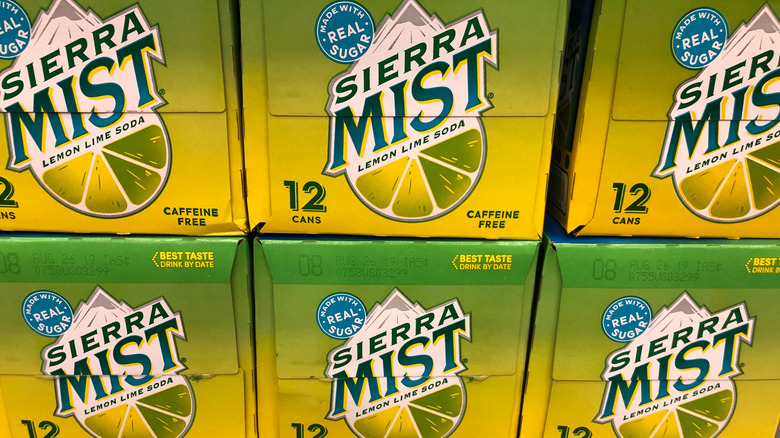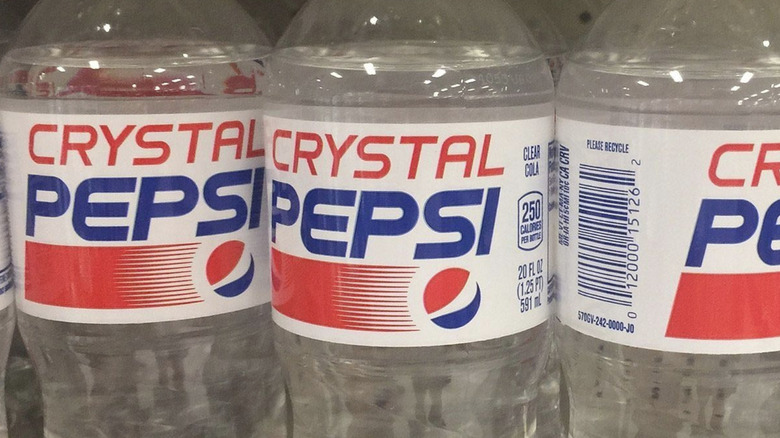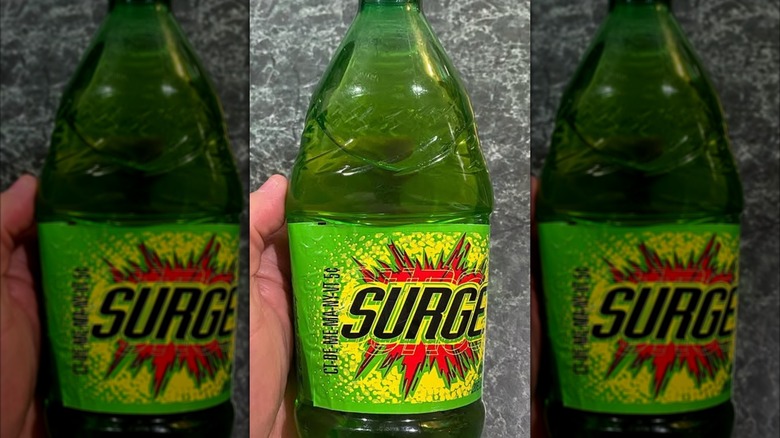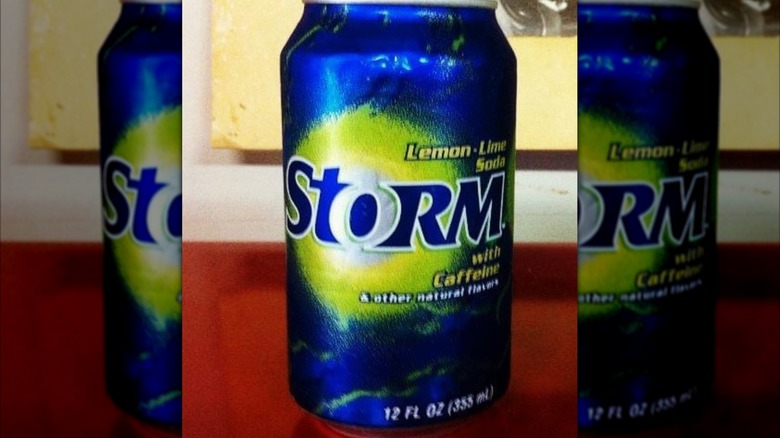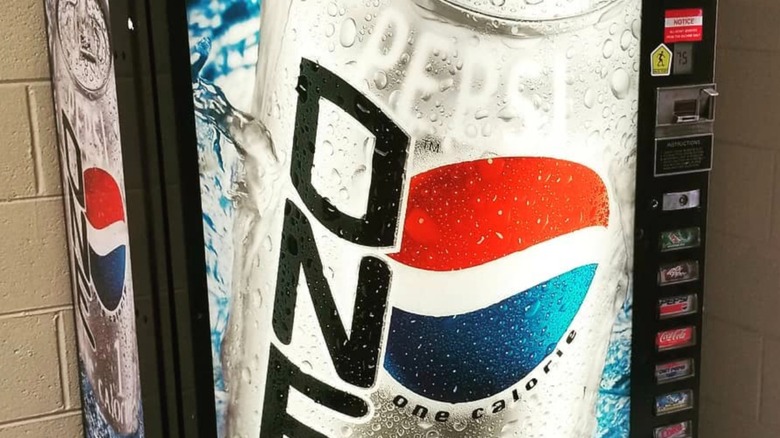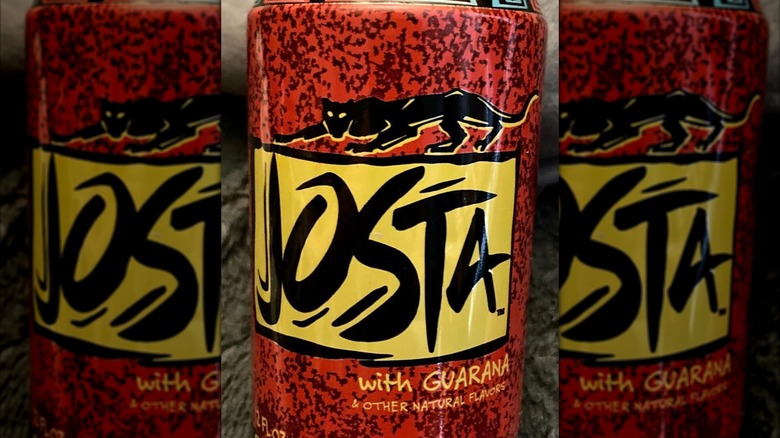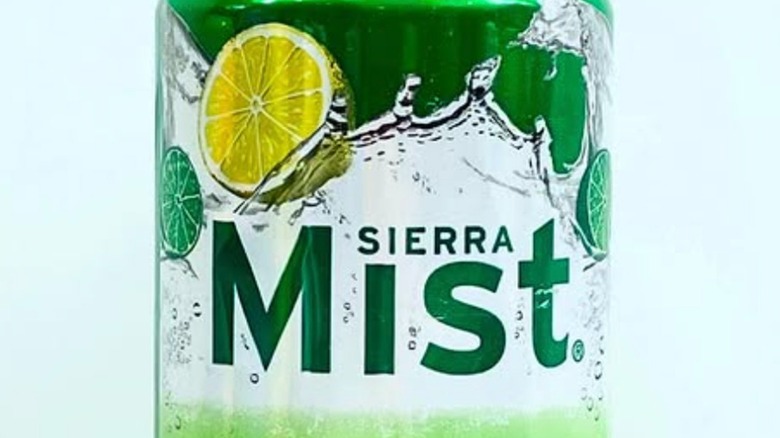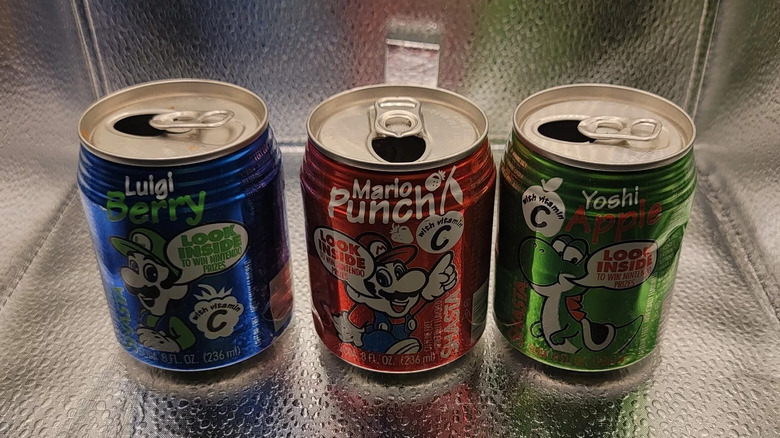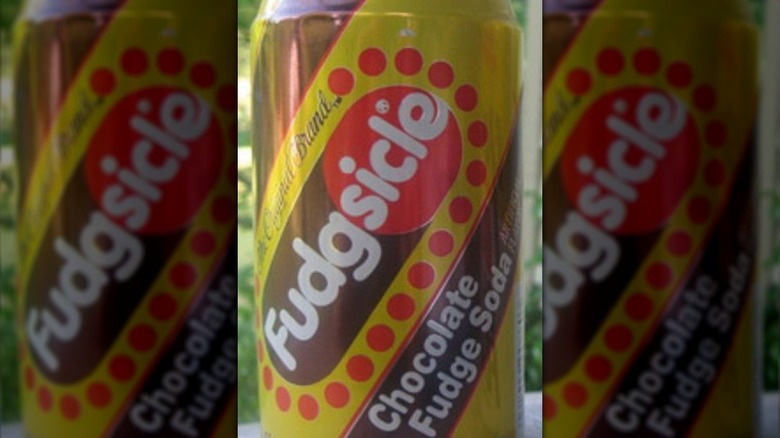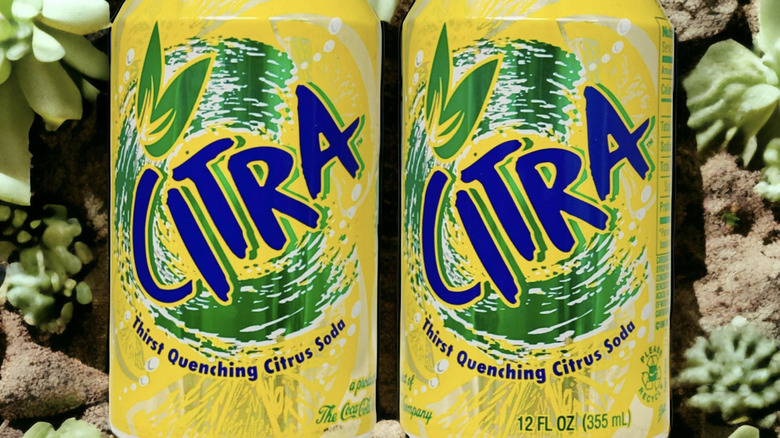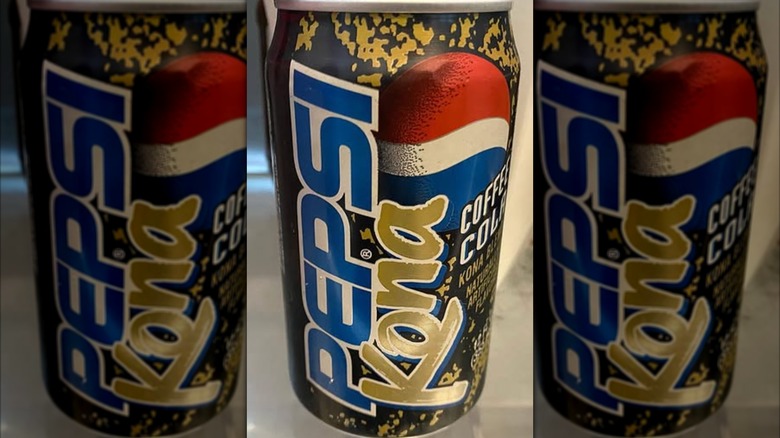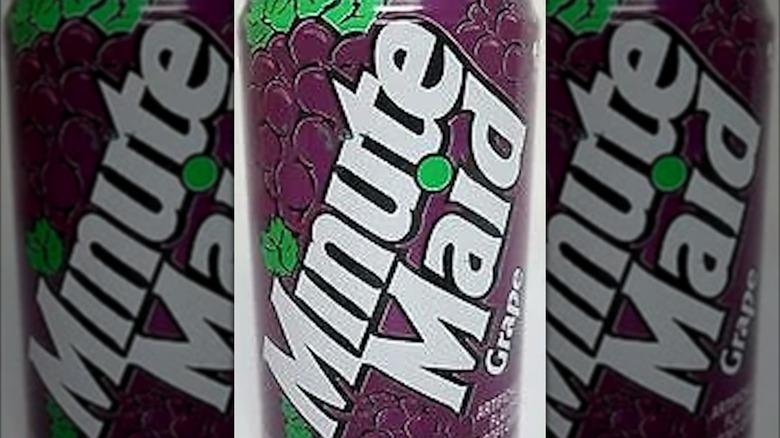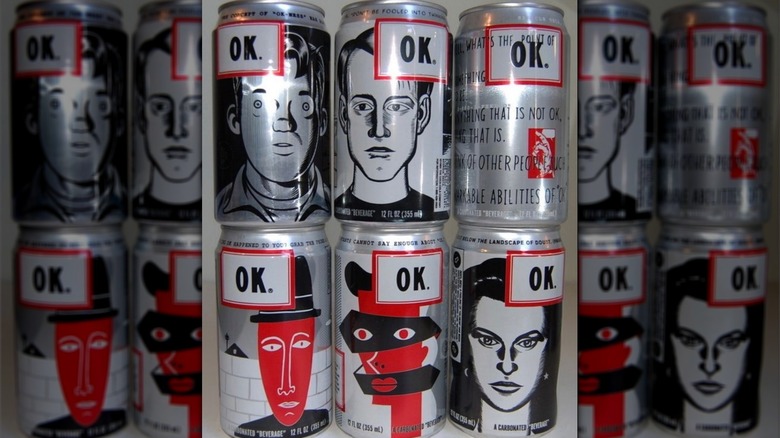Soda Flavors From The '90s That We Want Back
Perhaps it was the booming economy, or maybe it was a post-Cold War celebration of free-market capitalism — whatever the reason, the 1990s were arguably the golden age of delicious junk food. Fast food chains of all kinds were widespread during this decade, each offering up kooky new concoctions alongside the food companies braving new heights in preservative-laden, heavily-flavored, extra salty snacks. What went great with all those burgers, sandwiches, chips, and candy? A soda, of course.
Just like today, the likes of Coca-Cola, Pepsi, and Dr Pepper loomed large in the carbonated beverage industry. In the 1990s, anyone who made a lot of soda had to step up their game in order to stay relevant and win consumers' dollars. The huge soft drink firms were more than keen to experiment towards the end of the 20th century, flooding the market with brand-new bubbly beverages. But after the hype wore off, a lot of these sodas disappeared, leaving some fans wanting more. Here are some of the most quintessentially 1990s soda flavors that you can't find anymore, and, unlike the discontinued sodas we don't miss, we still miss.
Crystal Pepsi
Forever linked with the unique sensibilities of the 1990s, Crystal Pepsi was a product of its time. While its failure is arguably one of the biggest moments in Pepsi history, it enjoyed its brief moment on the cultural zeitgeist as much as customers enjoyed the quirky soft drink. By the 1990s, Coca-Cola and Pepsi were both about a century old, and they'd convinced the public that cola drinks had to be brown. Crystal Pepsi, however, was clear. It was part of a broader craze of the decade, in which beverage makers attempted to create a subconscious link between the clarity of a product and perceived cleanliness and healthfulness. Tab Clear, Miller Clear, Zima, and Crystal Pepsi were all clear, but it was the latter that got the most attention.
For what it's worth, Pepsi didn't expect its customers to buy a drink just because it was clear. Launched in 1992, Crystal Pepsi was ostensibly a cola, but it didn't taste exactly like Pepsi or other leading brands. It had a crisp mouthfeel and was less sweet than its caramel-hued counterpart. PepsiCo spent $40 million on the initial marketing for Crystal Pepsi, with this budget including a Super Bowl advertisement in 1993. Within two years, it appeared as if Crystal Pepsi was a failure. It had only managed to grab a 0.5% market share, leading Pepsi to stop production. Hardcore fans refused to accept the news, lobbying PepsiCo so consistently that Crystal Pepsi returned for brief production runs in 2016 and 2022. Watch this space to see if it can pull off another miraculous revival.
Surge
Unleashed on the soft drink-consuming public with a 1997 Super Bowl commercial, Surge was Coca-Cola's answer to — if not an optimistic improvement upon — PepsiCo's Mountain Dew. Just like the other citrus soda, Surge was colored a bright and sickly green. It was only lightly carbonated and packed with lots of sweetener and caffeine to fuel the activities of its target market of teenagers. Ads for the soft drink implied that it would provide a quick boost of energy and alertness. Surge was essentially a bridge between Mountain Dew and the energy drink phenomenon of the 2000s.
After a change-up in Coca-Cola's executive offices that led to a less aggressive approach to marketing, Surge sales started to slip. Also impacting the soft drink's popularity was the fact that some schools across the country banned the drink from vending machines, laboring under the false belief that Surge contained way more caffeine and sugar than Mountain Dew. In 2003, Coca-Cola decided to sunset Surge. The discontinued drink's fans organized and soon started a petitioning operation that resulted in over 30,000 signatures. Eventually, Surge did return for short periods of time in 2014 and 2015, but it failed to stick around for good.
Storm
Both 7UP and its primary competitor, Sprite, offer a mild and refreshing sweetened lemon-lime taste that serves as a nice alternative to cola. The one thing neither of those citrus sodas has, however, is caffeine. For years, 7UP commercials relied on bragging about this fact. Without a lemon-lime beverage of its own to vie for market share against 7UP and Coca-Cola's Sprite, PepsiCo tried to give consumers a new choice in the lemon-lime sector with the launch of Storm in the late 1990s.
Storm tasted very much like its two predecessors, but it packed the added value and utility of caffeine. Additionally, Storm wasn't as strongly carbonated as 7UP or Sprite, making for a smooth, less gas-intensive drinking experience. First appearing in 1998, it never got far out of the test-market phase. Pepsi called off the production of Storm before the '90s were over. It later launched a similar product in the form of Sierra Mist, only without caffeine in the formula.
Pepsi One
Diet Pepsi launched in the 1960s, and Diet Coke came along in the 1980s, and those were the main two options for Americans who wanted to drink cola but couldn't — or didn't want to — drink the regular, full-sugar stuff for medical or dietary reasons. Diet Pepsi, for example, didn't really taste like Pepsi at all, as it was made from a different recipe and made use of artificial sweeteners that resulted in a soda lacking the original's inspiration's bite, sweetness, and strong cola flavor. PepsiCo broke new ground in 1998 with the creation of Pepsi One.
A diet Pepsi that wasn't Diet Pepsi, Pepsi One was sweetened with the recently FDA-approved sweetener acesulfame potassium, as well as aspartame, with each serving containing a single calorie. More importantly, Pepsi One tasted a lot more like regular Pepsi than Diet Pepsi ever did. In 2005, PepsiCo reformulated Pepsi One, utilizing Splenda (aka sucralose) and a different recipe to even more closely replicate the taste of Pepsi in a sugar-free form. Nevertheless, demand and preference for Pepsi One steadily tapered off over the years, and in 2015, PepsiCo stopped making it.
Josta
Energy drinks are little more than soda, souped up with loads of extra caffeine and nutritional supplements. Sales on such products took off in the final years of the 20th century. One of the very first on the market was Josta, released to stores in 1996 by PepsiCo. A pioneer in function, Josta was a thick, syrupy, and very sugary soda. Josta was ostensibly a cola, but it was made from a variety of strong, luxurious, and complementary flavors that also tasted a little bit like medicine. This came from the inclusion of Josta's energy-providing and star ingredient: extract of guarana berries, a fruit native to South America.
Bottles and cans of Josta depicted a black panther and a Papyrus-like font, setting it apart aesthetically from other sodas on shelves at the time. Like the energy drinks for which it would later lay the market groundwork, Josta contained way more caffeine than regular sodas, and so it naturally appealed to teenagers and young adults. In fact, Josta only sold well among those demographics, which weren't exactly sizable enough for the drink to be profitable for PepsiCo. It ended production in early 1999.
Sierra Mist
Following the Cola Wars of the 1980s, which saw Coca-Cola and Pepsi aggressively vying for the hearts (and wallets) of consumers, the two soda juggernauts next took to battling it out over lemon-lime soft drinks. Back in the 1960s, Coca-Cola struck it rich with the clear, sweet, caffeine-free Sprite, itself formulated to compete with 7UP. At the tail end of the 1990s, Pepsi tried to carve out its own spot in the field with the introduction of Sierra Mist. Designed to emulate both 7UP and Sprite, Sierra Mist was also clear, caffeine-free, and tasted like a mix of lemon juice, lime juice, and soda water, although it was a bit sweeter than the other brands.
While Sierra Mist had its fans, it never really significantly impacted sales of the other major lemon-lime soft drink options. In early 2023, PepsiCo called off production of Sierra Mist in order to immediately give a very similar product a shot. Starry subsequently arrived in stores with a major marketing push. Available at the outset in both full-calorie and sugar-free versions, PepsiCo touted Starry as an improvement on the slightly different Sierra Mist, with a company spokesperson telling Fox Television Stations that it was packed with "higher citrus flavors that are true to fruit and more aromatic which delivers a more balanced, cleaner, crisp finish than Sierra Mist."
Super Mario Bros. sodas
Shasta is a carbonated soft drink brand that has always differentiated itself from the bigger providers through variety, today offering the likes of club soda, ginger ale, and its own take on Dr Pepper known as Dr. Shasta. In the 1990s, its latest owner, the National Beverage Corporation, decided to target what was seen as an underserved niche in the market: children. It acquired the license to make and market products bearing the names and images of characters from Nintendo's "Super Mario Bros." franchise, and in 1993, Shasta factories rolled out four different flavors of soda corresponding to a different character.
Each soda was packaged in an 8-ounce Kid Can, purposely smaller to make it easier for a child to wrap their hand around. Available varieties included Mario Punch, Luigi Berry, Princess Toadstool Cherry, and Yoshi Apple. By the time the child-oriented, fruit-flavored, and tantalizingly sweet Mario sodas hit the market, Nintendo was between system launches, and its popularity was on the decline. That couldn't have been good for sales of the Mario soft drinks. In 1994, just about a year after they were introduced, the sodas were discontinued.
Fudgsicle Chocolate Fudge Soda
While "popsicle" is the common word used to describe almost any kind of sweet frozen treat on a stick, it's actually a registered trademark of a company called Popsicle, which is now under the leadership of Good Humor-Breyers. Over the decades, Popsicle has launched a long list of ice cream-adjacent novelties, such as the orange-and-vanilla Creamsicle in 1937 and the extra-chocolatey Fudgsicle in 1946.
After years of dominating the supermarket freezer aisle and ice cream trucks with the industry standard in icy desserts on a stick, Popsicle attempted to launch a spinoff Fudgsicle product. In 1990, and with almost no marketing whatsoever, 12-ounce cans of Fudgsicle Chocolate Fudge Soda started appearing on grocery store shelves. With cans that mimicked the Fudgsicle box — yellow packaging dotted with red spots — the soda replicated the experience of eating a chocolate ice pop, albeit one that melted and had bubbles added. It was akin to a Yoo-hoo, but with carbonation. Despite its one-of-a-kind taste and name recognition, it seems like Fudgsicle Chocolate Fudge Soda couldn't muster enough interested consumers, as after roughly two years in the marketplace, it disappeared.
Citra
Fresca hit stores around the U.S. in 1967 as one of the first ever widely available sugar-free sodas. The beverage was so beloved by President Lyndon B. Johnson that he had a drink delivery button on his desk. For decades, its primary competitor in the sweetened grapefruit-flavored carbonated beverage space was Squirt, a full-sugar drink eventually acquired and distributed by Dr Pepper's parent company, Keurig Dr Pepper. Coca-Cola decided it needed to go head-to-head with Squirt's sugary take on the sweet-but-sour citrus-based beverage, and so introduced Citra in 1996.
With a name that suggests a citrus fruit blend, Citra was most prominently grapefruit flavored. It was extremely similar to Fresca in taste, except for the extra sting and resultant jolt that only a truly sugary beverage can provide. Citra hung around soda shelves in grocery and convenience stores for less than a decade. In 2004, Citra ended production, but in name only. Seeing success with Fanta, a line of variously fruit-based sodas, Coca-Cola went on to tweak the Citra recipe to begin bottling it as Fanta Citrus.
Pepsi Kona
Coffee is brown, caffeinated, and offers many layers of flavors and tasting notes. Cola is brown, caffeinated, and offers equally plentiful layers of flavors and notes. Both can benefit from just a hint of sweetness. PepsiCo realized that coffee and cola could potentially work well in tandem, and in 1996, it attempted to extend its product line by testing out a carbonated, coffee-flavored cola known as Pepsi Kona. It earned its name from the high-quality Kona coffee beans, which are grown in Hawaii — which, coincidentally, grows more coffee than any other U.S. state.
PepsiCo had a hard time getting its first tasters on board, including those who lived in specific Philadelphia areas where the soda was handed out for free from the Kona Hummer. It seems like cola diehards weren't enthusiastic about the addition of bitter coffee flavors, while coffee fans felt just fine sticking with the coffee they knew and loved. A planned national rollout of Pepsi Kona subsequently never came to fruition.
Minute Maid soda
The orange soda market exploded in the 1980s. With Crush and Sunkist already well established, PepsiCo introduced a mandarin orange flavor of Slice, and Coca-Cola rolled out an orange-flavored Minute Maid soda by decade's end. The flavor sold so well that Coca-Cola used the Minute Maid name to unleash a slew of other fruity sodas throughout the late 1980s and early 1990s. All sticky, powerfully sweet, and generously flavored, every entry in the Minute Maid line offered consumers an experience akin to drinking carbonated liquid candy.
First came lemon-lime in 1985, followed by strawberry in 1993, and then fruit punch and grape varieties in 1996. Minute Maid's fruit line made further inroads into the collective consciousness as a series of occasionally available Slurpee flavors at 7-Eleven stores. Lemon-lime, orange, strawberry, grape, and fruit punch were available for several years, but Coca-Cola eventually phased out the entire line by 2005. Lemon-lime Minute Maid was likely deemed redundant considering the popularity of Sprite, while the other flavors were well represented by Coca-Cola's more familiar — not to mention better-selling — global brand, Fanta.
OK Soda
By and large, carbonated soft drinks exist to fulfill perceived niches in terms of customer demand or need for a certain flavor or function. OK Soda doesn't necessarily fit that description, launched by Coca-Cola as more of a self-aware marketing gimmick than an actual soda engineered because it thought consumers might like it.
Debuting in the early 1990s, OK Soda had a novel, pleasing, and altogether relatively inoffensive taste, best described as somewhere in the vicinity of fruit punch blended with a citrus soda and a touch of cola added to the mix. Coca-Cola's marketing department took the lead on OK Soda. Fascinated with the supposed truth that the two best-known words around the world, despite language barriers, were "Coke" and "OK," Coca-Cola wanted to own both terms as far as consumerism was concerned.
The company had an uphill battle trying to make a drink whose name suggests mediocrity seem both palatable and interesting. Coca-Cola looked to the culture zeitgeist of the early 1990s and the Generation X-led sentiment of disenchantment and nihilism. Young people of the era were perceived to be unbothered, or "OK" with the world. Coca-Cola promoted OK Soda with the OK Manifesto, which, according to Time Magazine, contained taglines such as, "What's the point of OK soda? Well, what's the point of anything?" Its cans were decorated with bleak, slacker-style art created by alternative comic book artists such as Daniel Clowes. Coca-Cola started phasing out OK Soda in 1995, having sold a total of just 1 million cases since its launch in select test markets.
